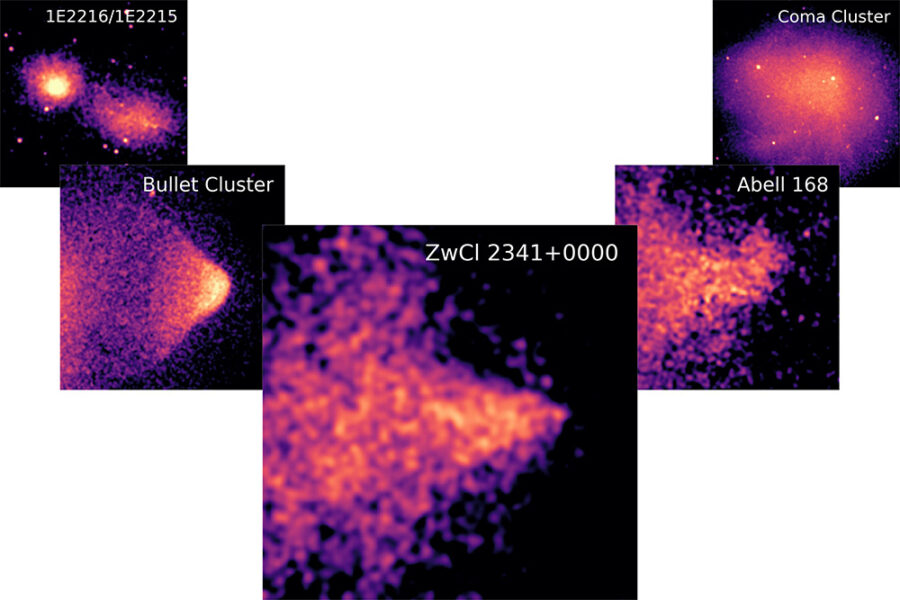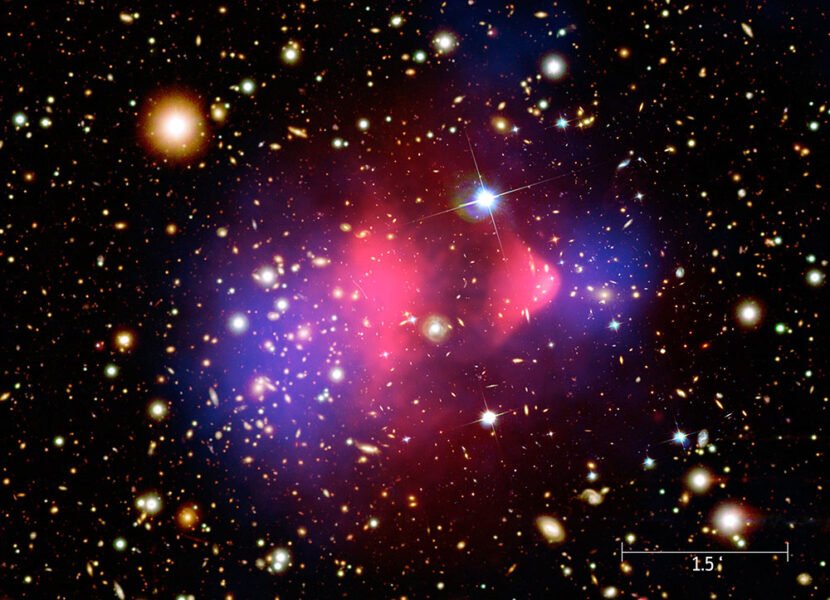Galaxy clusters take eons to collide. Now, astronomers have caught a pair of merging clusters in an in-between stage never seen before.

SRON Netherlands Institute for Space Research
For the first time, astronomers have seen a relatively short-lived stage that occurs during the collision of massive galaxy clusters. Computer simulations of such dramatic smash-ups have successfully reproduced the new observations.
A team led by Xiaoyuan Zhang (Leiden University and SRON Netherlands Institute for Space Research) used NASA’s Chandra X-ray Observatory to map the distribution of hot gas in the merging cluster pair named ZwCL 2341+0000, which is some 3 billion light-years distant in the constellation Pisces.
The team asked Chandra to stare at the remote cluster pair for 57 hours, collecting several thousands of X-ray photons. The observations revealed a sharp, cone-like structure of hot gas in between the colliding clusters, one of which is about three times more massive than the other. “It was really unexpected,” says coauthor Aurora Simionescu (SRON and Leiden University). “I had never seen anything like this before.”
When two clusters collide, their individual galaxies pass “through” each other relatively undisturbed. Just like the massive amounts of dark matter in the clusters, galaxies are “collisionless,” meaning they are only affected by their mutual gravity. The hot, X-ray-emitting intracluster gas, however, does collide, resulting in bow shocks and so-called “cold fronts” at the interface between gas volumes of different temperatures.

NASA / CXC / M. Weiss
In the early stages of a merger, these structures have a rather blunt appearance – a famous example is seen in the Bullet Cluster. In the final stages, the structures tend to curl back on themselves like breaking waves, giving them the appearance of a tongue or a slingshot. Astronomers have often observed both shapes – the blunt “bullet” and the wavy “tongue” — but the sharp cone shape seen in ZwCl 2341+0000 was new.
Zhang and his colleagues got in touch with John ZuHone (Center for Astrophysics, Harvard & Smithsonian), who has been carrying out computer simulations of colliding and merging galaxy clusters since 2011. According to ZuHone, such simulations reveal that cluster properties such as mass and density influence the distribution of X-ray-emitting gas, as do collision parameters such as angle and velocity.
In 2019 ZuHone and Bryan Brzycki (University of California, Berkeley) published more elaborate simulations that also incorporated the effects of magnetic fields. “When magnetic field lines are draped around the cold fronts, they tend to suppress the development of velocity perturbations,” says ZuHone. With magnetic fields keeping gas in line, the result is a much narrower structure, with relatively sharp edges that may be over a million light-years long.
New magnetohydrodynamic simulations tailored to the case of ZwCl 2341+0000 successfully reproduced the cone-shaped structure as a relatively short-lived feature, lasting for just a few hundred million years. Eventually, the gas will fall back into dark matter’s gravity well, says ZuHone, “sloshing around a bit like wine in a glass.”
The new Chandra observations and the results of the latest computer simulations are published in Astronomy & Astrophysics (preprint available here). The cluster “is likely in a short-lived phase that is rarely observed and offers an example of the complex transition between a bullet-like morphology and the development of a slingshot tail,” the authors write.
According to Simionescu, the new images of ZwCl 2341+0000 provide a sneak peek of how the famous Bullet Cluster might change its shape in a few hundred million years. Cluster collisions play themselves out on very slow timescales, adds ZuHone, but the nice thing about computer simulations is that they let you speed up time and place one observational snapshot into context in a billion-year-long movie.
 0
0









Comments
You must be logged in to post a comment.